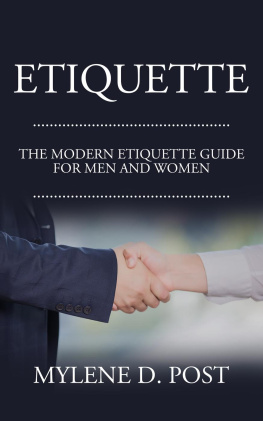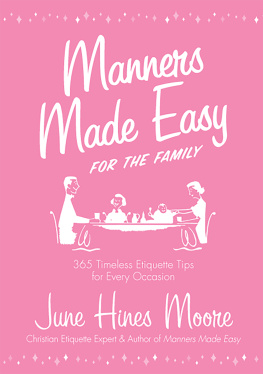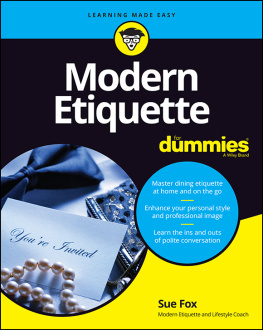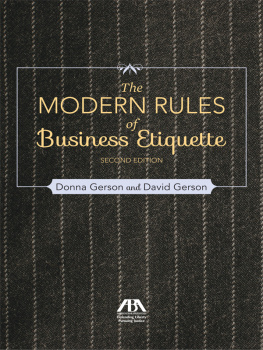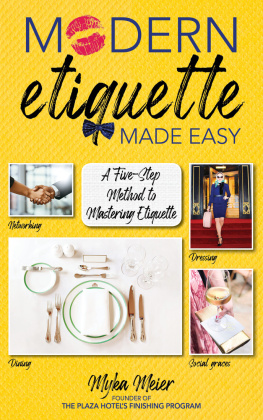Etiquette: The Modern Etiquette Guide for Men and Women
MYLENE D. POST
Published by wlsbooks, 2016.
While every precaution has been taken in the preparation of this book, the publisher assumes no responsibility for errors or omissions, or for damages resulting from the use of the information contained herein.
ETIQUETTE: THE MODERN ETIQUETTE GUIDE FOR MEN AND WOMEN
First edition. March 30, 2016.
Copyright 2016 MYLENE D. POST.
Written by MYLENE D. POST.
10 9 8 7 6 5 4 3 2 1
Introduction
I n this day and age, good manners seem to be diminishing. However, you can be an exception to this dreary trend by learning how to behave acceptably in the modern world.
This book will show you the basic as well as little known rules of modern etiquette. It includes the basic tips and strategies of everyday etiquette that your parents taught you when you were little, such as commonsense politeness, table manners, and proper conversational skills. Find out how you can be polite while using modern-day perks, such as mobile phones and email. You will also learn how to be courteous in modern situations such as during a job hunt, in the workplace, and in social gatherings.
Learning to become a modern-day lady or gentleman will benefit you and others in your personal and professional life. Let this book show you how to hone your modern etiquette qualities now!
Chapter 1 Everyday Etiquette
I n todays society, things are becoming increasingly fast-paced and casual. However, this does not mean that one should neglect etiquette or have the excuse to be rude just because one is in a hurry, or is busy. In fact, by respecting and being considerate of others, you can become all the more successful in the modern world.
Everyday etiquette is universal, commonsensical, and classic. While it does adapt to the times, it nevertheless serves the purpose of showing respect to others as well as to yourself. Rudeness is a quality that no society would ever accept, because it reveals how you believe you are more important than others.
You can start the habit of being courteous in everyday situations instantly by heeding the following basics:
Say the Magic Words
Please
How easy it really is to just add please to a request. No matter how important your position in society is, it is always charming to say, May I have a cup of coffee, please? as opposed to, One cup of coffee. The word please shows that you respect the person with whom you are speaking, and this is always appreciated.
Thank You
Saying thank you reveals a clear appreciation of someone elses show of affection or respect towards you. It is a way of making the other person who is helping out feel good for having done so, because you acknowledge his or her effort. Failing to thank someone will only increase the quality of being self-involved, regardless of whether the person notices it or not.
Youre Welcome
If someone else thanks you for the kindness youve shown, it is best to respond with youre welcome. Some people feel uncomfortable to say this, but do know it is perfectly all right to feel confident in acknowledging someones appreciation for the effort you have made. Furthermore, by doing so, you are reinforcing the other persons attitude of gratitude.
Im Sorry
Sincerely saying Im sorry, regardless of the magnitude of the problem, shows that you are mature, kind, and gracious. Saying these magic words also helps diffuse a difficult situation, especially when the other party is angry. It is also proper etiquette to say Im sorry when you hear that someones loved one human or animal has passed away.
Excuse Me
If you have caused an inconvenience to someone else, no matter how small, it is necessary to say excuse me or pardon me. By doing so, you are letting the other person know that you are aware of how you are inconveniencing them and that it is not intentional. Some people mistakenly believe that certain situations are exempted, but in truth, it does not hurt to say these two words in any given situation.
The most common situations in which to say excuse me are:
- when you have to interrupt someone (Excuse me, but James would like to talk to you);
- leave a conversation or a group who is in the middle of a social gathering, especially from a table (Excuse me, but I have to go to the ladies room);
- made a mistake or committed a socially awkward act, such as burping (Excuse me);
- and to request for something (Excuse me, but may I borrow your pen?).
***
F ollow the Polite Way to Greet Someone
Saying hello and introducing yourself to someone will always place you and the other person in a positive scenario. It will enable you to make a good impression on others by showing respect for them and acknowledging their presence.
Start at Home
Polite greetings always start in the home. The atmosphere becomes much warmer when family members or roommates say good morning upon seeing each other for the first time each day, or by saying, Im home when you arrive from work or school.
Formal Greetings
In formal occasions such as businesses or meetings with clients, it is always best to start with Good morning (or afternoon, or evening); How do you do? or Hello followed by the persons title and last name. For example: How do you do, Professor Smith? Deliver it in a genuine and confident manner with a clear and polite tone.
Informal Greetings
Acknowledging someone informally can be in the verbal or gestural form. The latter is used when the other person wont be able to hear you say hi, such as by smiling and nodding or waving your hand. It is also polite to greet back to the people who say hello to you even if it is their duty to do so, such as security guards, waiters, and cashiers.
Saying hello does not mean you have to spend more time talking to them, and if the person stops to chat, you can politely state your reason why you have to leave.
Standards Steps When Greeting Someone
You can practice being confident and cheerful when greeting somebody. Start by standing up and then extending your hand to the person, at the same time saying your greeting (Formal: Hello, Informal: Hi). Make eye contact and show a warm smile. When the other person takes your hand, hold it firmly (not painfully), and shake it three times. Then, let go of his or her hand.
If you are unable to shake hands with someone else who has extended his or her arm to yours, simply explain why you cannot. For example: Im sorry, I broke my wrist a few days ago, so I cant shake hands with you. I truly am glad to meet you, though.
You may have noticed that, aside from the handshake, another common gesture for greeting someone is the kissing on the cheeks. In this case, simply mirror the other persons behavior. If you are not comfortable with this, then take the initiative of greeting someone and then gracefully extending your arm to show that you are the handshake type of person.
***
P olitely Introduce Someone
Take care not to forget to introduce the people you are with to each other if it is the first time they have met. If you are unsure of how to do this, keep in mind the following guidelines:
Step 1: Acknowledge this person first by saying his or her name or title:
- Family members older than you or are senior to you, such as your parents, boss, client, or guest of honor.
- For example: Grandma, Id like you to meet...
Step 2: Mention this persons name to introduce him or her to the person who is older than you or senior to you:
- Someone who is younger than you or is your contemporary.
- For example: ...my boyfriend, Chris.
As a general rule of thumb, you are to acknowledge the more important person first and then introduce the other to him before the other way around.

